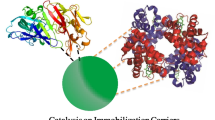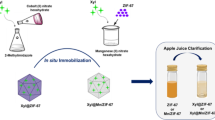Abstract
Amano lipase AK from P. fluorescens was immobilized on different types of chitosan-containing supports. Chitosan lower molecular weight (2.5%), chitosan lower molecular weight/sodium alginate (2.5%/2.5%) and chitosan lower molecular weight/carrageenan (2.5%/2.5%) allowed the highest values of immobilization yields (IY) of 81, 81 and 83%, respectively. Best activity results were achieved using chitosan average molecular weight (5%) and chitosan lower molecular weight/sodium alginate (2.5%/2.5%) as support, with values of 1.40 and 1.30 UpNPB/ggel and with recovery activities of 45.75 and 35.6%, respectively. These derivatives were evaluated in the kinetic resolution of rac-indanol to obtain a key intermediate in the synthesis of a drug used in the treatment of Parkinson's disease. The most efficient derivatives in the kinetic resolution were lipase immobilized on chitosan average molecular weight (5.0%) and chitosan low molecular weight/sodium alginate, the latter leading to obtaining both (S)-indanol and (R)-indanyl acetate with > 99% ee and 50% conversion.



Similar content being viewed by others
References
Jung H, Lee Y, Kim D et al (2012) Enzymatic production of glycerol carbonate from by-product after biodiesel manufacturing process. Enzyme MicrobTechnol 51:143–147. https://doi.org/10.1016/j.enzmictec.2012.05.004
Puskas JE, Seo KS, Sen MY (2011) Green polymer chemistry: Precision synthesis of novel multifunctional poly(ethylene glycol)s using enzymatic catalysis. EurPolym J 47:524–534
Törnvall U, Orellana-Coca C, Hatti-Kaul R, Adlercreutz D (2007) Stability of immobilized Candida antarctica lipase B during chemo-enzymatic epoxidation of fatty acids. Enzyme MicrobTechnol 40:447–451
Zhong L, Feng Y, Wang G et al (2020) Production and use of immobilized lipases in/on nanomaterials: a review from the waste to biodiesel production. Int J Biol Macromol 152:207–222. https://doi.org/10.1016/j.ijbiomac.2020.02.258
Facin BR, Melchiors MS, Valério A et al (2019) Driving immobilized lipases as biocatalysts: 10 years state of the art and future prospects. Ind Eng Chem Res 58:5358–5378. https://doi.org/10.1021/acs.iecr.9b00448
Miyako E, Maruyama T, Kamiya N, Goto M (2003) Enzyme-facilitated enantioselective transport of (S)-ibuprofen through a supported liquid membrane based on ionic liquids. Chem Commun 3:2926–2927. https://doi.org/10.1039/b310990a
Brem J, Turcu MC, Paizs C et al (2012) Immobilization to improve the properties of Pseudomonas fluorescens lipase for the kinetic resolution of 3-aryl-3-hydroxy esters. Process Biochem 47:119–126. https://doi.org/10.1016/J.PROCBIO.2011.10.020
Lima GVGV, da Silva MR, de Sousa Fonseca T et al (2017) Chemoenzymatic synthesis of (S)-Pindolol using lipases. ApplCatal A Gen 546:7–14. https://doi.org/10.1016/j.apcata.2017.08.003
Bezerra RM, Neto DMA, Galvão WS et al (2017) Design of a lipase-nano particle biocatalysts and its use in the kinetic resolution of medicament precursors. Biochem Eng J 125:104–115. https://doi.org/10.1016/j.bej.2017.05.024
Pereira MG, Facchini FDA, Polizeli AM et al (2015) Stabilization of the lipase of Hypocrea pseudokoningii by multipoint covalent immobilization after chemical modification and application of the biocatalyst in oil hydrolysis. J MolCatal B Enzym 121:82–89
Toscano L, Montero G, Stoytcheva M et al (2014) Comparison of the performances of four hydrophilic polymers as supports for lipase immobilisation. Biotechnol Biotechnol Equip 28:52–60. https://doi.org/10.1080/13102818.2014.901684
Rios NS, Morais EG, dos Santos Galvão W et al (2019) Further stabilization of lipase from Pseudomonas fluorescens immobilized on octyl coated nanoparticles via chemical modification with bifunctional agents. Int J Biol Macromol. https://doi.org/10.1016/j.ijbiomac.2019.09.003
Pinheiro BB, Rios NS, Rodríguez Aguado E et al (2019) Chitosan activated with divinyl sulfone: a new heterofunctional support for enzyme immobilization. Application in the immobilization of lipase B from Candida antarctica. Int J Biol Macromol 130:798–809. https://doi.org/10.1016/j.ijbiomac.2019.02.145
Díaz Ramos M, Giraldo Gómez GI, Sanabria González N (2014) Immobilization of Candida rugosa lipase on bentonite modified with benzyltriethylammonium chloride. J MolCatal B Enzym 99:79–84. https://doi.org/10.1016/J.MOLCATB.2013.10.021
De Lima LN, Aragon CC, Mateo C et al (2013) Immobilization and stabilization of a bimolecular aggregate of the lipase from Pseudomonas fluorescens by multipoint covalent attachment. Process Biochem 48:118–123. https://doi.org/10.1016/j.procbio.2012.11.008
Aires-Trapote A, Hoyos P, Alcántara AR et al (2015) Covalent immobilization of pseudomonas stutzeri lipase on a porous polymer: an efficient biocatalyst for a scalable production of enantiopure benzoin esters under sustainable conditions. Org Process Res Dev 19:150219160910000. https://doi.org/10.1021/op500326k
Rios NS, Mendez-Sanchez C, Arana-Peña S et al (2019) Immobilization of lipase from Pseudomonas fluorescens on glyoxyl-octyl-agarose beads: improved stability and reusability. Biochim Biophys Acta Proteins Proteomics. https://doi.org/10.1016/j.bbapap.2019.06.005
Manoel EA, dos Santos JCS, Freire DMG et al (2015) Immobilization of lipases on hydrophobic supports involves the open form of the enzyme. EnzymeMicrobTechnol 71:53–57. https://doi.org/10.1016/j.enzmictec.2015.02.001
Rios NS, Pinheiro BB, Pinheiro MP et al (2018) Biotechnological potential of lipases from Pseudomonas: sourcses, properties and applications. Process Biochem. 75:99–120
Gilbert EJ (1993) Pseudomonas lipases: biochemical properties and molecular cloning. Enzyme MicrobTechnol 15:634–645. https://doi.org/10.1016/0141-0229(93)90062-7
Larson S, Day J, Greenwood A et al (1991) Preliminary investigation of crystals of the neutral lipase from Pseudomonas fluorescens. J Mol Biol 222:21–22. https://doi.org/10.1016/0022-2836(91)90732-L
Sulaiman S, Mokhtar MN, Naim MN et al (2015) A review: potential usage of cellulose nanofibers (CNF) for enzyme immobilization via covalent interactions. Appl Biochem Biotechnol 175:1817–1842. https://doi.org/10.1007/s12010-014-1417-x
Danial EN, Elnashar MMM, Awad GEA (2010) Immobilized inulinase on grafted alginate beads prepared by the one-step and the two-steps methods. Ind Eng Chem Res 49:3120–3125. https://doi.org/10.1021/ie100011z
Bilal M, Iqbal HMN (2019) Naturally-derived biopolymers: potential platforms for enzyme immobilization. Int J Biol Macromol 130:462–482. https://doi.org/10.1016/j.ijbiomac.2019.02.152
Dinçer A, Becerik S, Aydemir T (2012) Immobilization of tyrosinase on chitosan-clay composite beads. Int J Biol Macromol 50:815–820. https://doi.org/10.1016/j.ijbiomac.2011.11.020
Monteiro RRC, Lima PJM, Pinheiro BB et al (2019) Immobilization of lipase a from candida antarctica onto chitosan-coated magnetic nanoparticles. Int J Mol Sci 20:4018. https://doi.org/10.3390/ijms20164018
Silva JAA, Macedo GPP, Rodrigues DSS et al (2012) Immobilization of Candida antarctica lipase B by covalent attachment on chitosan-based hydrogels using different support activation strategies. Biochem Eng J 60:16–24. https://doi.org/10.1016/j.bej.2011.09.011
dos Santos JCS, Bonazza HL, de Matos LJBL et al (2017) Immobilization of CALB on activated chitosan: application to enzymatic synthesis in supercritical and near-critical carbon dioxide. Biotechnol Reports 14:16–26. https://doi.org/10.1016/J.BTRE.2017.02.003
da Pereira AS, Diniz MM, De Jong G et al (2019) Chitosan-alginate beads as encapsulating agents for Yarrowia lipolytica lipase: morphological, physico-chemical and kinetic characteristics. Int J Biol Macromol 139:621–630. https://doi.org/10.1016/j.ijbiomac.2019.08.009
Kılınç A, Teke M, Önal S, Telefoncu A (2006) Immobilization of pancreatic lipase on chitin and chitosan. Prep Biochem Biotechnol 36:153–163. https://doi.org/10.1080/10826060500533976
de Oliveira UMF, Matos LJBM, Souza MC et al (2017) Effect of the presence of surfactants and immobilization conditions on catalysts’ properties of rhizomucor miehei lipase onto chitosan. Appl Biochem Biotechnol 184:1263–1285. https://doi.org/10.1007/s12010-017-2622-1
Gómez L, Ramírez HL, Villalonga ML et al (2006) Immobilization of chitosan-modified invertase on alginate-coated chitin support via polyelectrolyte complex formation. Enzyme MicrobTechnol 38:22–27. https://doi.org/10.1016/J.ENZMICTEC.2004.10.008
Liu Q, Hua Y, Kong X et al (2013) Covalent immobilization of hydroperoxide lyase on chitosan hybrid hydrogels and production of C6 aldehydes by immobilized enzyme. J MolCatal B Enzym 95:89–98
Sudhir MS, Venkata Nadh R (2013) Rasagilinehemitartrate: synthesis, characterization and RP-HPLC validation for its estimation in bulk form. Drug Invent Today 5:133–138. https://doi.org/10.1016/j.dit.2013.05.002
Bradford MM (1976) A rapid and sensitive method for the quantitation of microgram quantities of protein utilizing the principle of protein-dye binding. Anal Biochem 72:248–254. https://doi.org/10.1016/0003-2697(76)90527-3
de Fonseca TS, da Silva MR, de Oliveira MDCF et al (2015) Chemoenzymatic synthesis of rasagiline mesylate using lipases. ApplCatal A Gen 492:76–82. https://doi.org/10.1016/j.apcata.2014.12.015
Lee SH, Kim IS, Li QR et al (2011) Stereoselective amination of chiral benzylic ethers using chlorosulfonyl isocyanate: Total synthesis of (+)-Sertraline. J Org Chem 76:10011–10019. https://doi.org/10.1021/jo201794k
Kim MJ, Hyun MK, Kim D et al (2004) Dynamic kinetic resolution of secondary alcohols by enzyme-metal combinations in ionic liquid. Green Chem 6:471–474. https://doi.org/10.1039/b405651e
de Souza TC, de Fonseca ST, da Costa JAJA et al (2016) Cashew apple bagasse as a support for the immobilization of lipase B from Candida antarctica: application to the chemoenzymatic production of (R)-Indanol. J MolCatal B Enzym 130:58–69. https://doi.org/10.1016/j.molcatb.2016.05.007
Merabet-Khelassi M, Houiene Z, Aribi-Zouioueche L, Riant O (2012) Green methodology for enzymatic hydrolysis of acetates in non-aqueous media via carbonate salts. Tetrahedron Asymmetry 23:828–833. https://doi.org/10.1016/j.tetasy.2012.06.001
Galvão WS, Pinheiro BB, Golçalves LRB et al (2018) Novel nanohybrid biocatalyst: application in the kinetic resolution of secondary alcohols. J Mater Sci. https://doi.org/10.1007/s10853-018-2641-5
Acknowledgements
The authors thank to the Fundação Cearense de Apoio ao Desenvolvimento Científico e Tecnológico (FUNCAP) for financial support (Process: DEP-0164-00236.02.00/19; SPU Nº: 1910216698), Conselho Nacional de Desenvolvimento Científico e Tecnológico (CNPq) and Coordenação de Aperfeiçoamento de Ensino Superior (CAPES) for fellowships and financial support. The authors thank the research sponsorships of M. C. de Mattos (Process: 306043/2018-1) and M. C. F. de Oliveira (Process: 307667/2017-0). Nathalia S. Rios thanks to Programa Nacional de Pós-Doutorado (PNPD/CAPES) for Post-Doctoral fellowship. The authors thank the Northeastern Center for Application and Use of NMR (CENAUREMN) for NMR spectroscopy.
Author information
Authors and Affiliations
Corresponding authors
Ethics declarations
Conflicts of interest
The authors declared that no competing interests exist.
Additional information
Publisher's Note
Springer Nature remains neutral with regard to jurisdictional claims in published maps and institutional affiliations.
Rights and permissions
About this article
Cite this article
de Sousa Fonseca, T., de Oliveira, U.M.F., de Oliveira, M.d.C.F. et al. Immobilization of Amano lipase AK from Pseudomonas fluorescens on different types of chitosan-containing supports: use in the kinetic resolution of rac-indanol. Bioprocess Biosyst Eng 44, 785–792 (2021). https://doi.org/10.1007/s00449-020-02487-2
Received:
Accepted:
Published:
Issue Date:
DOI: https://doi.org/10.1007/s00449-020-02487-2




